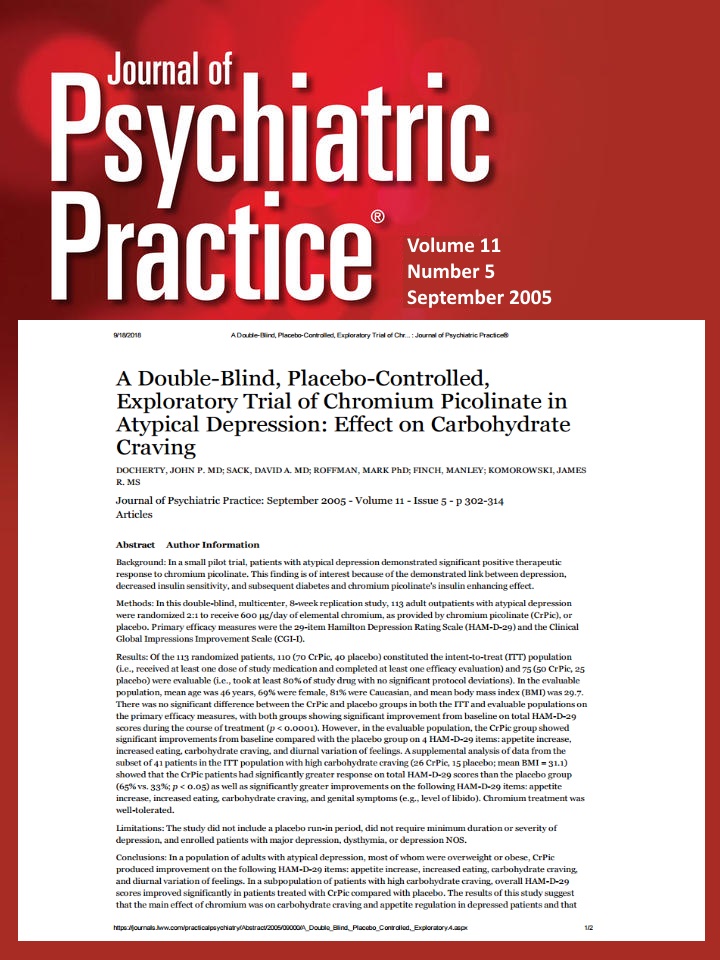A double-blind, placebo-controlled, exploratory trial of chromium picolinate in atypical depression: effect on carbohydrate craving

Abstract:
BACKGROUND: In a small pilot trial, patients with atypical depression demonstrated significant positive therapeutic response to chromium picolinate. This finding is of interest because of the demonstrated link between depression, decreased insulin sensitivity, and subsequent diabetes and chromium picolinate’s insulin enhancing effect.
METHODS: In this double-blind, multicenter, 8-week replication study, 113 adult outpatients with atypical depression were randomized 2:1 to receive 600 mug/day of elemental chromium, as provided by chromium picolinate (CrPic), or placebo. Primary efficacy measures were the 29-item Hamilton Depression Rating Scale (HAM-D-29) and the Clinical Global Impressions Improvement Scale (CGI-I).
RESULTS: Of the 113 randomized patients, 110 (70 CrPic, 40 placebo) constituted the intent-to-treat (ITT) population (i.e., received at least one dose of study medication and completed at least one efficacy evaluation) and 75 (50 CrPic, 25 placebo) were evaluable (i.e., took at least 80% of study drug with no significant protocol deviations). In the evaluable population, mean age was 46 years, 69% were female, 81% were Caucasian, and mean body mass index (BMI) was 29.7. There was no significant difference between the CrPic and placebo groups in both the ITT and evaluable populations on the primary efficacy measures, with both groups showing significant improvement from baseline on total HAM-D-29 scores during the course of treatment (p < 0.0001). However, in the evaluable population, the CrPic group showed significant improvements from baseline compared with the placebo group on 4 HAM-D-29 items: appetite increase, increased eating, carbohydrate craving, and diurnal variation of feelings. A supplemental analysis of data from the subset of 41 patients in the ITT population with high carbohydrate craving (26 CrPic, 15 placebo; mean BMI = 31.1) showed that the CrPic patients had significantly greater response on total HAM-D-29 scores than the placebo group (65% vs. 33%; p < 0.05) as well as significantly greater improvements on the following HAM-D-29 items: appetite increase, increased eating, carbohydrate craving, and genital symptoms (e.g., level of libido). Chromium treatment was well-tolerated.
LIMITATIONS: The study did not include a placebo run-in period, did not require minimum duration or severity of depression, and enrolled patients with major depression, dysthymia, or depression NOS.
CONCLUSIONS: In a population of adults with atypical depression, most of whom were overweight or obese, CrPic produced improvement on the following HAM-D-29 items: appetite increase, increased eating, carbohydrate craving, and diurnal variation of feelings. In a subpopulation of patients with high carbohydrate craving, overall HAM-D-29 scores improved significantly in patients treated with CrPic compared with placebo. The results of this study suggest that the main effect of chromium was on carbohydrate craving and appetite regulation in depressed patients and that 600 mug of elemental chromium may be beneficial for patients with atypical depression who also have severe carbohydrate craving. Further studies are needed to evaluate chromium in depressed patients specifically selected for symptoms of increased appetite and carbohydrate craving as well as to determine whether a higher dose of chromium would have an effect on mood.
A Double-blind, placebo-controlled, exploratory trial
Docherty JP, Sack DA, Roffman M, Finch M, Komorowski JR:
J Psychiatr Pract 11(5): 302-314 , 2005 16184071
